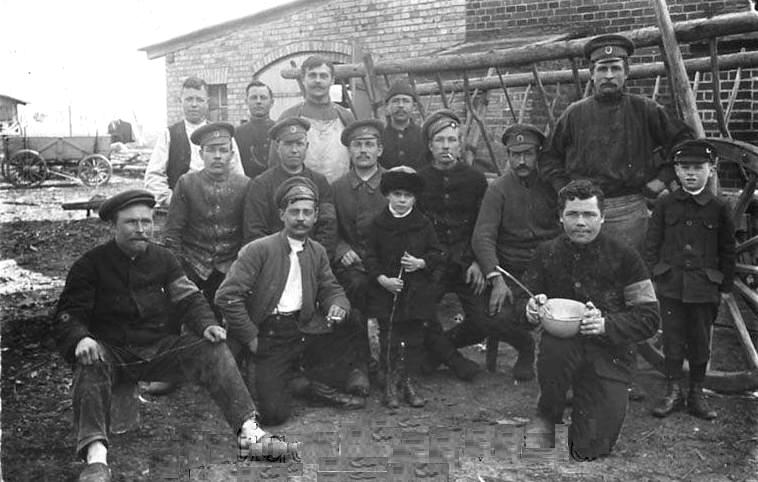
World War I POW Country Trends: The Central Powers

Figure 1.--This photgraph was identified only as 'Russian POWs'. Given the boys present, we can assume that they were being held in either Ausria-Hungary or Germany. We would guess Austria-Hungary. We think they were being used for agricutral labor. With the conscription of workers there was a serious labor shortge. The boys have clearly made friends with the men, suggesting to us that the men weree beng treated correctly and humanely. The photograph is undated, but we suspect was fairly early in the War, perhaps 1915.
|
|
Germany held 2.5 million prisoners during World War I. Allied POWs were held in Austrian, Bulgarian, German, Hungarian, and Turkish prison camps. There were 180 of these camps in Germany and Austria-Hungary. The largest numbers of Allied POWs were Russians. The Austrians held mostly Russian POWs. Treatment dependended somewhat on nationality. The Austians and Germans tended to treat the Serbs harshly. Some other Allied POWs reported harsh treatment. But for the most part the Central Powers tended to treat allied POWs relatively humanely. There were international inspections of Central Powers POW camps. The Red Cross played an especilly impotant role. James W. Gerard, United Stares Ambassador in Berlin, oversaw the investigations until the United States entered the war (April 1917). Life in Central Power prison camps was undeniably difficult and got more difficult as the War progressed and food shortages developed. German and Austro-Hungarian authorities made an effort to follow international law and promote the health and welfare of POWs. There were exceptions. Some reports suggest that the Germans did not treat British POWs correctly early in the War.
Unlike World War II, such repots seem were relatively few in mumber. After the beginning of the War, they were mostly due to individual camp commandants and not mational policies. A more serious problem was German reprisals for preceived British and French mistreatment of their POWs. This resulted in the Germans using Allied POWs for forced labor on the Eastern Front, sometimes in horific conditions. The Ottoman Turks were a major exception to the humane treatment of prisoners. The Ottoman Empire had an especially poor record of treating POWs. Some 16,600 British and Indian officers and men were captured by the Ottomans. Their fate and conditions under which they were head greatly concecened the British and Indian Governments. Some 11,800 British soldiers, mostly Indians, were tken prisoners after the 5-month Siege of Kut, in Mesopotamia (April 1916). Many were already weak and starving when they finally surrendered and 4,250 died in Turkish captivity.
CIH

Navigate the CIH World War I Pages:
[Return to Main World War I POW country page]
[Return to Main World War I POW page]
[Return to Main World War I casualty page]
[Return to Main World War I page]
[Return to Main World War II POW page]
[Aftermath]
[Alliances]
[Animals]
[Armistace]
[Biographies]
[Causes]
[Campaigns]
[Casualties]
[Children]
[Countries]
[Declaration of war]
[Deciding factors]
-------[Diplomacy]
[Economics]
-------[Geo-political crisis]
[Home front]
[Intelligence]
[Military forces]
[Neutrality]
[Pacifism]
[People]
[Peace treaties]
[Propaganda]
[POWs]
[Russian Revolution]
[Terrorism]
[Trench warfare]
------[Technology]
[Weaponry]
[Bibliographies]
[Contributions]
[FAQs]
[Images]
[Links]
[Registration]
[Tools]
[Return to Main World War I page]
[Return to Main war essay page]
[Return to CIH Home page]
Created: 10:35 AM 5/5/2016
Last updated: 10:35 AM 5/5/2016



